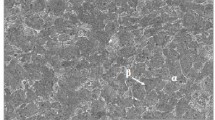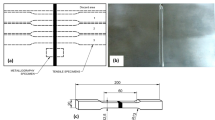Abstract
Commercially pure titanium is used for low-temperature applications due to good toughness attributed to single-phase microstructure (α). Electron beam welding (EBW) and gas tungsten arc welding (GTAW) processes have been used for welding two grades of commercially pure titanium (Grade 2 and Grade 4). Martensitic microstructure is found to be finer in the case of EBW joint as compared to GTAW joint due to faster rate of cooling in the former process. Weldments have been characterized to study the mechanical behavior at ambient (298 K) and cryogenic temperatures (20 and 77 K). Strength of weldments increases with the decrease in temperature, which is found to be more prominent in case of Grade 4 titanium as compared to Grade 2. Weld efficiency of Grade 4 is found to be higher at all the temperatures (ambient, 77 and 20 K). However, ultimate tensile strength/yield strength ratio is higher for Grade 2 as compared to Grade 4. % Elongation is found to increase/retained at cryogenic temperatures for Grade 2, and it is found to decrease for Grade 4. Electron backscattered diffraction analysis and transmission electron microscopy of deformed samples confirmed the presence of extensive twinning in Grade 2 and the presence of finer martensitic structure in Grade 4. Fractography analysis of tested specimens revealed the presence of cleavage facets in Grade 4 and dimples in specimens of Grade 2. Higher strength in Grade 4 is attributed to higher oxygen restricting the twin-assisted slip, which is otherwise prominent in Grade 2 titanium.










Similar content being viewed by others
References
N. Saresha, M.G.K. Pillai, and J. Mathew, Investigations into the Effects of Electron Beam Welding on Thick Ti-6Al-4V Titanium Alloy, J. Mater. Proc. Technol., 2007, 192–193, p 83
R.R. Boyer, An Overview on the use of Titanium in the Aerospace Industry, Mater. Sci. Eng. A, 1996, 213(1–2), p 103
N. Kahraman, Joint of Titanium Plates to Different Metals by Explosive Welding Method and Investigation of Their Interface Properties. Ph.D. thesis, Gazi University, Ankara, Turkey, 2003.
S. Lathabai, B.L. Jarvis, and K.J. Barton, Comparison of Keyhole and Conventional Gas Tungsten Arc Welds in Commercially Pure Titanium, Mater. Sci. Eng. A, 2001, 299, p 81
C. Aparicio, G.F. Javier, C. Fonseca, M. Barbosa, and P. Anton, Corrosion Behaviour of Commercially Pure Titanium Shot Blasted with Different Materials and Sizes of Shot Particles for Dental Implant Applications, Biomaterials, 2003, 24(2), p 263
H.H. Huang, Effects of Fluoride Concentration and Elastic Tensile Strain on the Corrosion Resistance of Commercially Pure Titanium, Biomaterials, 2002, 23, p 59
J.C. Williams, Kinetics and phase transformation, Titanium Science and Technology, Vol 3, R.I. Jaffee and H.M. Burte, Ed., Plenum Press, London, 1973, p 1433–1494
W.A. III, Baeslack, J.M. Gerken, C. Cross, J. Hanson, P.S. Liu, J.C. Monses, J. Schley, and L. Showalter, Titanium and titanium alloys, Welding Handbook, Vol 4, 8th ed., J.M. Gerken, Ed., American Welding Society, Miami, 1998, p 488–540
R.T. Webster, Welding of titanium alloys, Soldering, ASM Handbook, Vol 6, 9th ed., Brazing Welding, Ed., ASM International, Metals Park, 1993, p 783–786
Y. Qi, J. Deng, Q. Hong, and L. Zeng, Electron Beam Welding, Laser Beam Welding and Gas Tungsten Arc Welding of Titanium Sheet, Mater. Sci. Eng. A, 2000, 280, p 177
M.G. Pillai, R.K. Gupta, B. Pant, and P.S. Sreejith, Role of Material Thickness on Tensile Properties of Ti6Al4 V Welds, Trans. IIM, 2015, 68(3), p 423
I. Uygur and I. Dogan, The Effect of TIG Welding on Microstructure and Mechanical Properties of a Butt-Joined-Unalloyed Titanium, J. Metal., 2005, 44(2), p 119
P. Danielson, R. Wilson, and D. Alman, Microstructure of Titanium Welds, Adv. Mater. Proc., 2003, 161(2), p 39
P.E. Denney, B.W. Shinn, and F.P. Mike, Stabilization of pulsed GMAW in titanium welds with low-power lasers, Proceedings of 23rd International Congress on Applications of Lasers and Electro-Optics (ICALEO), 2004, p 10.
http://www.ewi.org/uploads/insights/Spring2004_HeavyManufacturing.pdf.
L. Won-Bae, L. Chang-Young, C. Woong-Seong, Y. Yun-Mo, and J. Seung-Boo, Microstructural Investigation of Friction Stir Welded Pure Titanium, Mater. Lett., 2005, 59, p 3315
C. Li, K. Muneharua, S. Takao, and H. Kouji, Fiber Laser-GMA Hybrid Welding of Commercially Pure Titanium, Mater. Des., 2009, 30, p 109
Lu Wei, Yaowu Shi, Yongping Lei, and X. Li, Effect of Electron Beam Welding on the Microstructures and Mechanical Properties of Thick TC4-DT Alloy, Mater. Des., 2012, 34, p 509
Wu Bing, Li Jinwei, and Tang Zhenyun, Study on the Electron Beam Welding Process of ZTC4 Titanium Alloy, Rare Metal., 2014, 4, p 786
Z. Bing-gang, S. Ming-Xiao, C. Guo-qing, and F. Ji-cai, Microstructure and Defect of Titanium Alloy Electron Beam Deep Penetration Welded Joint, Trans. Nonferr. Met. Soc. China, 2012, 22, p 2633
O. Grong, Metallurgical Modelling of Welding, The Institute of Materials, London, 1994 (Chapter 1)
K. Easterling, Introduction to the Physical Metallurgy of Welding, Butterworth and Co., London, 1983
J.W. Elmer, J. Wong, M. Froba, P.A. Waide, and E.M. Larson, Analysis of Heat-Affected Zone Phase Transformations Using In-Situ Spatially Resolved X-Ray Diffraction With Synchrotron Radiation, Metall. Mater. Trans. A, 1996, 27A, p 775
T.R. McNelly and H. Charles Heikkenen, Superplasticity in aerospace II, 119th Meeting of the Metallurgical Society, T.R. McNelly and H. Charles Heikkenen Eds., TMS, Warrendale, 1990, p. 317–332.
R.I. Jaffee, Metallurgical synthesis, Titanium Science and Technology, Vol 3, R.I. Jaffee and H.M. Burte, Ed., Pleunum Press, London, 1973, p 1665–1693
J.B. Newkirk and A.H. Geisler, Crystallographic Aspects of the Beta to Alpha Transformation in Titanium, Acta Metall., 1953, 1, p 370
A.J. Williams, R.W. Cahn, and C.S. Barrett, The Crystallography of the β–α Transformation in Titanium, Acta Metall., 1954, 2, p 117
J.E. Gould, D. Becker, and J.C. Williams, Microstructural characterization of Ti weldments, Physical Metallurgy of Metal Joining, R. Kossowsky and M.E. Glicksman, Ed., The Metallurgical Society of AIME, Warrendale, 1980, p 199–221
J.C. Chestnutt, C.G. Rhodes, and J.C. Willimas, Relationship between mechanical properties, microstructure, and fracture topography in α-β titanium alloys, Fractrography—Microscopic Cracking Processes, ASTM STP 600, ASTM, Philadelphia, 1976, p. 99–138.
K. Mukugi, N. Ouchi, A. Takemura, and Y. Morimoto, Low temperature mechanical properties of titanium and weld joints (Ti/Ti, Ti/Nb) for helium vessels, The 10th Workshop on RF Superconductivity, 2001, Tsukuba, Japan, p. 473–476.
Q.Y. Sun and H.C. Gu, Tensile and Low Cycle Fatigue Behaviour of Commercially Pure Titanium and Ti5Al2.5Sn Alloy at 293 and 77K, Mater. Sci. Eng. A, 2001, 316, p 80
R. Stevenson and J.F. Breedis, Cyclic Deformation of Commercial-Purity Titanium, Acta Metall., 1975, 23, p 1419
S. Nemat-Nasser, W.G. Guo, and J.Y. Cheng, Mechanical Properties and Deformation Mechanisms of Commercially Pure Titanium, Acta Mater., 1999, 47(13), p 3705
V.A. Moskalenko and A.R. Smirnov, Temperature Effect on Formation of Reorientation Bands in α-Ti, Mater. Sci. Eng. A, 1998, 246, p 282
R.R. Boyer, Titanium & Its Alloys: Metallurgy, Heat Treatment and Alloy Characteristics. Materials and Process Technology, The Boeing Company, Seattle, Encyclopedia of Aerospace Engineering, Wiley, London, 2010
M. Yan, W. Xu, M.S. Dargusch, H.P. Tang, M. Brandt, and M. Qian, Review of Effect of Oxygen on Room Temperature Ductility of Titanium and Titanium Alloys, Powder Metal., 2014, 57(4), p 251
P.F. Fu, Z.Y. Mao, Y. Jun, W.C. Zuo, and H. Xu, Mechanical Properties of Ti6.5Al2Zr1Mo1 V Titanium Alloy with EBW Under Different Temperatures, Mater. Sci. Eng. A, 2014, 608, p 199
S. Wang and X.Q. Wu, Investigation on the Microstructure and Mechanical Properties of Ti–6Al–4 V Alloy Joints with Electron Beam Welding, Mater. Des., 2012, 36(8), p 663
J.N. DuPont, Lehigh University, Fundamentals of Weld Solidification, Welding Fundamentals and Processes, T. Lienert, T. Siewert, S. Babu, and V. Acoff, Eds., ASM Handbook, Vol 6A, ASM International, Metals Park, 2011, p. 97–114
H. Liu, K. Nakata, J.X. Zhang, N. Yamamoto, and J. Liao, Microstructural Evolution of Fusion Zone in Laser Beam Welds of Pure Titanium, Mater. Charact., 2012, 65, p 1
S.K. Kim and J.K. Park, In-Situ Measurement of Continuous Cooling β → α Transformation Behaviour of CP–Ti, Metall. Mater. Trans. A, 2002, 33, p 1051
M.S. Oh, J.-Y. Lee, and J.K. Park, Continuous Cooling β-to-α Transformation Behaviors of Extra-Pure and Commercially Pure Ti, Metall. Mater. Trans. A, 2004, 35, p 3071
W.F. Smith, Structure and Properties of Engineering Alloys, 2nd ed., McGraw-Hill, New York, 1993
Acknowledgments
Authors thank DD, MME, VSSC for providing guidance during this work and Director, VSSC, for his kind permission to publish the work.
Author information
Authors and Affiliations
Corresponding author
Rights and permissions
About this article
Cite this article
Gupta, R.K., Anil Kumar, V. & Xavier, X.R. Mechanical Behavior of Commercially Pure Titanium Weldments at Lower Temperatures. J. of Materi Eng and Perform 27, 2192–2204 (2018). https://doi.org/10.1007/s11665-018-3307-9
Received:
Revised:
Published:
Issue Date:
DOI: https://doi.org/10.1007/s11665-018-3307-9




